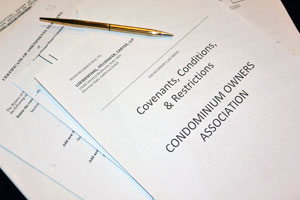LHC Newsletter Vol. 4, No. 1
“THE COLLECTION END GAME: How To Maximize Recovery, Minimize Costs And Generate Cash Flow”
By Robert D. Hillshafer, Esq.
Although the concept of “fiduciary duty” is mentioned frequently (often incorrectly) as applying to the duties of community association board of directors in general, one area in which it does certainly apply is relative to collection of Association assessments. Because Associations operate on a “zero based budget”, which means that every dollar of assessments is budgeted to be spent annually (except for reserve contributions), the duty of Boards to collect assessments is perhaps the single-most important one because without revenues, the Association cannot afford to carry out its other legal obligations to maintain the property, insure the property and all the ancillary activities which are necessary to preserve the value of the separate interests within a community association.
However, in a difficult economic climate where unemployment is high, investments are down and foreclosures are rampant, the duty of a Board to collect assessments becomes something of a “Catch-22″ because performance of this duty necessitates the expenditure of Association resources in many instances. The necessity of expenditures in the collection context has become magnified greatly over the past several years as a result of an “activist” California legislature that has simultaneously made the process more onerous on and expensive for Association’s and far less efficient in collecting the necessary monies to comply with the obligations under California law and the governing documents. Consequently, for a Board to properly carry out its fiduciary duty to collect assessments from members without concurrently wasting Association resources in the process, a “cookie-cutter” approach must be discarded and serious investigation and cost/benefit analysis needs to be performed before taking action and incurring expense.
There are four potential avenues of recovery of delinquent assessments available to community associations. They are:
- Small claims court action for amounts under $5,000;
- Non-judicial foreclosure of assessment lien;
- Judicial foreclosure of assessment lien;
- Superior Court action for money judgment.
Each of these avenues have positives and negatives relative to effectiveness and expense. The difficult question is: Which one is correct?
The two fundamental questions which a Board must answer in determining the best collection path to take are: (1) what is the probability of actually collecting the delinquency; and (2) in light of (1), what is the most efficient and cost-effective means of accomplishing collection or forcing the title of the separate interest to change hands.
The answers to the first question come from an analysis of a variety of factors, some of which are objective in nature and others which simply relate to common sense. The collection process invariably starts with a “pre-lien” letter being sent to the delinquent owner to put them on notice that they are delinquent, that the Association will be taking action to collect and advising the owner of their statutory rights to dispute the claim and engage in internal dispute resolution. When an Association refers a collection matter to me to generate a pre- lien letter, as part of my flat fee, my firm performs the following analysis:
- obtain grant deed to determine current titleholder
- obtain all deeds of trust against property to determine how much debt is against the property
- obtain any and all pending notices of default or notices of sale by a mortgagee (lender) to determine how far in arrears the owner is on a mortgage/mortgages
- obtain a property profile which shows purchase price, debt and comparable current property values
If my analysis of these documents indicates that there is (1) no equity in the property based on the loan to current value; or (2) a significant arrearage on a senior mortgage, I will generally advise my client that the probability of recovery of money is doubtful and that the Board should pursue a strategy that minimizes expenses to the Association and expeditiously seeks to force the lender to foreclose. Regardless of what ultimate strategy is chosen, I do recommend recordation of an assessment lien against the separate interest because it puts the lender on notice and because it forces the owner to deal with us if a “short sale” is attempted.
In the institutional lending crisis experienced over the last several years, we have seen the phenomenon of lenders refusing to pull the trigger on seriously defaulted loans so that they would not have to assume the liability for payment of assessments on the separate interest in the future. I have seen lenders wait over two years to complete a foreclosure for this purpose. From recordation of the notice of default, the minimum time for a lender to complete a foreclosure is approximately 110 days. If that time period has not been exceeded when we obtain the notice of default, and a notice of sale has been published, I will often recommend that my client go forward with the lien recordation but then “sit tight” on further affirmative action to see if the owner cures or the lender forecloses. If the time period has elapsed or sales have been postponed, I will contact the trustee and attempt to determine whether a short sale is being considered or if the lender is just stalling.
Unless firm information is received about a sale or short sale, it generally means that the lender is stalling. When that conclusion is reached, I generally tell my clients that the debt will probably be uncollectible and that the lender needs to be pushed to foreclose or the owner pushed to cure. The most viable and cost effective way to do that is through a non- judicial foreclosure. This is because the time frame is fixed (approximately 110 days) and cost is established by California law so the Association will at least know what the cost exposure will be ahead of time.
There is still a possibility that even if the Association does foreclose, the lender may not act immediately and hold its own Trustee’s sale. If the Association does foreclose, the owner still has a 90 day period to “redeem” the property from the foreclosing association for all assessments and costs incurred. If the property is occupied, an unlawful detainer action may have to be filed to obtain physical possession of the property. This obviously creates an additional expense to the Association so before taking this step, efforts should be made to determine what the lender is going to do.
If the Association does foreclose on the property, the Association no longer has a monetary claim against the owner for the delinquency under the “one action rule.” However, if the Association does take possession and ownership, it theoretically could attempt to lease out the unit or even attempt to sell it, subject to the lender’s security interest. Unfortunately, sales or leasing by Association’s rarely result in a substantial recovery by the association. Moreover, pursuant to Civil Code Section 890, some attorneys believe that it could be a criminal violation to accept rents during the first year after foreclosing without payment of the rent toward the mortgage debt. This issue requires careful consideration by Association legal counsel if the situation reaches that point.
MITIGATION METHODS: GET THE PROCESS STARTED EARLIER/CONSIDER PAYMENT PLANS
Although most Board’s would like to believe that the Association should function as a community, with respect, deference and trust being exhibited toward the members, when it comes to collection issues, that approach just reflects bad business, particularly during tough economic periods. Below are a few recommendations I routinely make to Boards to help mitigate delinquency problems:
- Adoption of a policy to initiate the pre-lien collection process immediately when an owner becomes delinquent. California law provides that an assessment is delinquent on the 16th day after it is due. Most associations wait until a second assessment is not paid before the account is sent to collection, which puts the Association at least 45 days behind in starting the process. The sooner the process begins, including the investigation discussed above, the sooner the Board will be able to make pragmatic decisions about which path to take and how it can be most cost- effective. Even though an association cannot initiate a foreclosure on an assessment lien until the delinquent assessments are $1800 or have been delinquent 12 months, a lien securing the delinquency may still be recorded 30 days after the pre-lien notice is sent. Note: adoption of such a policy does not have to go through the operating rule change process in Civil Code Section 1357.100 because collection policies are not operating rules.
- Periodic written notices to members advising of a “no tolerance” for late or delayed payments. Advise members of the immediate financial consequence to them for being even a few days late.
- Affirmatively advocate payment by direct deposit by owners of assessments. Create incentives for payment by this method, such as a five dollar per month administrative charge for payment by check.
- Even though an account is referred to collections, have management or the Board reach out telephonically to determine what the reason for non-payment is.
- Accept partial payments while the collection process is on- going.
- Serious consideration of incremental payment proposals by owners, even for extended periods, provided that a lien is recorded, future assessments are paid current and in full and an accelerated enforcement procedure is agreed to in the event of a default. The acceleration provision would include a waiver by the owner of the right to demand internal or alternative dispute resolution prior to the initiation of a foreclosure and waive certain time frames.
Budget for Delinquencies and Collection Costs
It is inevitable that an Association will have some uncollectible assessments and will incur attorneys fees and costs in carrying out its fiduciary duty. The ultimate impact of those inevitable short falls and expenses can be mitigated by budgeting for both part of the Association’s annual budget. The prior year’s history of delinquencies and collection costs can be used as a rough guide in setting these levels.
©2010 by Loewenthal, Hillshafer & Carter, LLP. All rights reserved. Permission is granted to reproduce or transmit in any form any part of this newsletter as long as proper attribution to Loewenthal, Hillshafer & Carter, LLP is given. Due to the rapidly changing nature of the law, information contained in this publication may become outdated. As a result, lawyers and
all others using this material must research original sources of authority.


